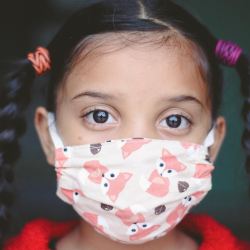Scientific American says there's good evidence to support mandatory masking in schools. A careful look at the data suggest the situation is more complicated.
In August 2020, Scientific American offered its readers some spot-on advice about how to evaluate the constant stream of COVID-19 research we're all subjected to. Quoting evolutionary biologist Carl Bergstrom, the magazine noted:
As soon as the paper comes out, whatever side that paper supports picks that paper up and uses it to beat the other side with. Both sides often are selectively cherry-picking from the results that favor them. It comes back, again, to finding these trusted sources. You want to find sources that are not trying to promote one particular political narrative around the disease.
Scientific American presumably considers itself one of these trusted sources, immune to the temptation of pushing a particular political narrative and willing to carefully evaluate all the evidence. Yet on September 16, SciAm ran this story: Masks Protect Schoolkids from COVID despite What Antiscience Politicians Claim:
"On July 30 Florida governor Ron DeSantis issued an executive order barring local school districts from requiring their students to wear masks, claiming that mask mandates in schools lack “a well-grounded scientific justification.” … DeSantis is wrong. And so is Texas governor Greg Abbott, who banned schools in his state from requiring masks and is suing some school districts for mandating them. There are multiple lines of evidence from a variety of disciplines … showing that masks can help protect children and teachers from getting COVID in schools."
Credit: Scientific American
We have a clear political narrative and, as we'll see, an instance of very careful cherry-picking in this Scientific American story. The key issue isn't that masks are useless. They can offer some protection in certain circumstances, but we need to know more than that. How much protection do they offer? Moreover, are the “multiple lines of evidence” strong enough to justify masks mandates in schools?
No, they're not. We can confirm this by looking more carefully at the research SciAm cited and bringing a few other studies into the discussion. SciAm in quotes, followed by my commentary:
"Researchers at the ABC Science Collaborative have collected data from more than a million K–12 students and staff members in North Carolina, which mandated masking in schools from August 2020 until July 2021. The scientists reported little in-school transmission over the fall, winter or summer months. Incidents remained low even as, in communities outside the schools, levels of COVID cases fluctuated and mitigation strategies shifted."
This study had no control group, as the authors themselves acknowledged, because every school in the state had a mask mandate in place. The researchers had no influence over North Carolina's masking policy, of course, but it's hard to investigate the efficacy of an intervention when you can't utilize the proper study design.
They tried to compensate by comparing their results to transmission rates at youth camps in Texas and Florida, as well as an unmasked school in Israel, but these numbers came from different studies; the researchers could only observe these settings from a distance. In any case, when you compare masked to unmasked settings, the outcomes aren't consistent. Many mandate-free schools around the world haven't experienced massive case surges.
A look at childhood transmission
What seems clear is that the risk of transmission increases with age, meaning that “children may have a lower susceptibility to SARS-CoV-2 infection and severe disease,” according to a September 13 study in BMC Pediatrics. Multiple papers published throughout the pandemic have confirmed this conclusion. Even post-delta, it appears that children don't transmit the virus very well, according to a recent study from Australia's National Center for Immunization Research and Surveillance (NCIRS).
The highest transmission rate in the study occurred between staff members at schools and day care centers, followed by staff-to-student transmission. Interestingly, most of the people who had primary cases caught COVID-19 from household contacts, not from exposure in an educational setting. “The spread between children themselves was very low,” NCIRS director Kristine Macartney told The Guardian. In other words, kids aren't infecting everyone else willy-nilly. This partisan slugfest over masking in schools seems mostly pointless given that context.
Back to Scientific American:
"An international team of researchers conducted a randomized controlled trial involving nearly 350,000 people across 600 villages in rural Bangladesh. Half of the villages got free cloth or surgical masks and a promotional campaign encouraging their use. The other half did not. The researchers found that the intervention significantly curbed coronavirus transmission, especially in villages that received surgical masks."
The study involved no children, unless everyone under 40 counts as a child, and the results weren't statistically significant for anyone under 50. Additionally, the study was mostly conducted outdoors, meaning it has little relevance to viral transmission in settings like classrooms and crowded cafeterias. Moreover, the surgical mask intervention “significantly curbed” transmission because cloth masks had essentially no effect, what the study authors called “an imprecise zero.” You can read my full analysis of the study here. My colleague Dr. Chuck Dinerstein also wrote a helpful breakdown of the paper.
"But [University of Wisconsin mechanical engineer David Rothamer] … says that when you put together the steady stream of research conducted thus far—and there are more than a dozen studies beyond those cited here—the accumulation of evidence points to the same conclusion: masks work."
Let's consider some of the research SciAm didn't cite. Several of the studies lacked control groups, just like the North Carolina study, or yielded statistically insignificant results. Others, like this Cochrane Collaboration review published in November 2020, found that “The pooled results of randomized trials did not show a clear reduction in respiratory viral infection with the use of medical/surgical masks during seasonal influenza.” There's many other studies that complicate Scientific American's straightforward analysis, which I discuss here: COVID-19: Let's Stop Fighting Over Masks And Get More People Vaccinated
Say what you mean
Masking is a low-risk, inexpensive intervention. If we want to recommend it as a precautionary measure, especially in situations where vaccination isn't an option, great. But that's not what the public has been told. “Florida governor Ron DeSantis and politicians in Texas say research does not support mask mandates,” SciAm's sub-headline bellowed. “Many studies show they are wrong.”
If that's the case, demonstrate that the intervention works before you mandate its use in schools. If you can't, acknowledged what UC San Francisco hematologist-oncologist and Associate Professor of Epidemiology Vinay Prasad wrote over at the Atlantic:
"No scientific consensus exists about the wisdom of mandatory-masking rules for schoolchildren … In mid-March 2020, few could argue against erring on the side of caution. But nearly 18 months later, we owe it to children and their parents to answer the question properly: Do the benefits of masking kids in school outweigh the downsides? The honest answer in 2021 remains that we don’t know for sure."

